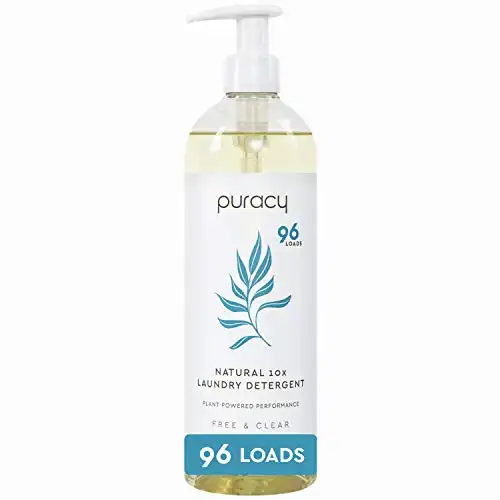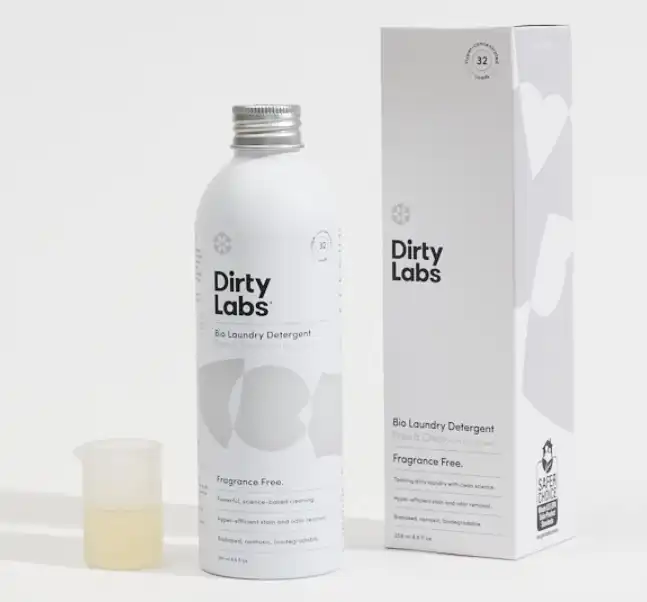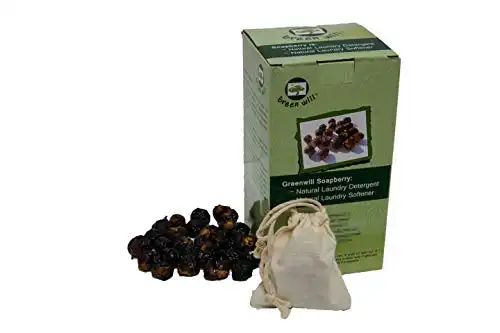- You are here:
- Home »
- Non Toxic Home Poducts »
- Laundry Detergent Dangers: Is Your Family’s Health at Risk?
Is Laundry Detergent Toxic?
There’s a lot of debate about whether or not laundry detergent is toxic. Some people claim that it can cause all sorts of health problems, while others say that it’s perfectly safe. So, what’s the truth? Is laundry detergent toxic or not?
Well, to answer that question, we need to take a closer look at what exactly laundry detergent is made of and what kinds of effects it can have on our health.
What Is Laundry Detergent And What Does It Do?
Laundry detergent is a product that is used to clean clothes and other textiles. A laundry detergent works by breaking down the dirt and stains on fabrics. The different chemicals in laundry detergent help to loosen dirt and stains so that they can be easily removed during the washing process.
Laundry detergent also helps to remove odors from sheets and clothes. This is because the detergent contains chemicals that interact with the odor molecules and break them down.
A delicate and hypoallergenic laundry detergent free from toxic chemicals: no phosphates, sulfates, petrochemicals, animal by-products, chlorine, perfumes, gluten, tree nut-based ingredients, dyes, allergens.
What Are The Chemicals In Laundry Detergent?
Laundry detergents contain a variety of chemicals, including surfactants, enzymes, fragrances, and dyes. Surfactants are chemicals that reduce the surface tension of water, making it easier to clean sheets and other fabrics. Enzymes are proteins that break down stains and dirt.
Fragrances are used to add a pleasant smell to detergent. Dyes are used to give detergent a color. Some laundry detergents contain bleach to maintain the color of white sheets and to kill bacteria. Formaldehyde is also sometimes added to laundry detergent to help keep clothes and sheets looking new and disinfect them.
Are the Chemicals in Laundry Detergent Harmful to Our Health?
While laundry detergent is designed to clean our bedding and clothes, it can also be harmful to our health. Most laundry detergents contain chemicals that have been linked to cancer, birth defects, and reproductive problems. Studies have shown that these chemicals can enter our bodies through our skin or when we breathe in the fumes from the detergent.
In addition, these chemicals can build up in our environment, where they can be harmful to wildlife. While there are some eco-friendly laundry detergents on the market, they can be more expensive than traditional detergents.
However, the peace of mind that comes with knowing you’re not exposing yourself and your family to harmful chemicals may be worth the extra cost.

Some of the Toxic Chemicals in Laundry Detergents Are:
- 1,4-dioxane: This chemical is a known carcinogen. It is commonly found in laundry detergents that contain fragrances.
- Nonylphenol ethoxylated (NPEs): These chemicals can disrupt the hormone system and cause reproductive problems.
- Phthalates: These chemicals can disrupt the hormone system and cause reproductive problems.
- Tris(2-chloroethyl) phosphate (TCEP): This chemical can have a negative effect on fertility.
- Formaldehyde: This chemical is a known carcinogen.
- Bleach: This chemical can damage the liver, kidney, and respiratory system. It can also irritate the skin.
- Phosphates: They have been linked to cardiovascular issues and osteoporosis. They´ve been found to be especially harmful once they get to the water system, where they can encourage the growth of algae. As the algae die, they deplete the oxygen in the water, which can be harmful to fish and other aquatic life.
Read More: Is Seventh Generation Eco-Friendly?
How Does Laundry Detergent Pollute the Environment?
Laundry detergent is toxic to the environment because it contains harsh chemicals that can contaminate soil and water. When these chemicals enter the environment, they can harm aquatic life and plants. In addition, they can cause respiratory problems in humans and animals.
Laundry detergent is also a major source of microplastics. Microplastics are tiny pieces of plastic that can pollute the environment and cause harm to wildlife. When laundry detergent is washed down the drain, it breaks down into smaller pieces of plastic that end up in our waterways and oceans.
These microplastics can be ingested by fish and other marine life, and they can also absorb toxins from the environment. This can cause serious health problems for wildlife and humans.
It is important to be mindful of laundry detergent’s impact on the environment. Many eco-friendly options are available that are just as effective as traditional laundry detergent. By switching to an eco-friendly option, you can help reduce the amount of pollution caused by laundry detergent.
Read More: Why Should You Use Wool Dryer Balls?
How To Reduce the Toxicity of Laundry Detergent?
When it comes to laundry detergent, there are a few things you can do to reduce the toxicity. First, choose a detergent that is phosphate-free and biodegradable, such as Dirty Labs.
Also, make sure to dilute the detergent properly according to the instructions on the bottle. Finally, avoid using too much detergent, as this can lead to toxic runoff. By following these simple tips, you can help reduce the toxicity of your laundry detergent and create a safer environment for your family.

How to Find a Safe Laundry Detergent?
When it comes to laundry detergent, there are a few things you need to look for to ensure you’re getting a non-toxic product. Take a look at our recommendations:
EWG Certified Laundry Detergents
The Environmental Working Group (EWG) provides a list of laundry detergents that have been evaluated in terms of toxicity. The EWG provides scores from Verified (the safest) to F (the most toxic) for products has been vetted for their ingredients and manufacturing processes. Some examples of EWG-evaluated laundry detergents that scored A include Attitude, Dirty Labs, and Grab Green.
You can find the list of EWG-evaluated laundry detergents here.
Natural Plant-Based Laundry Detergents
Another option for non-toxic laundry detergent is to choose a plant-based product. Plant-based laundry detergents are made with ingredients that come from plants, and they are often free of synthetic fragrances as well.
One example of a plant-based laundry detergent is Puracy Natural Laundry Detergent. This detergent is made with plant-derived ingredients and it is free of synthetic fragrances, dyes, and optical brighteners.
Soap Nut Shells
Unlike other laundry detergents that rely on harsh chemicals to get your sheets clean, soap nut shells rely on a natural cleaning agent called saponin. Saponin is found in many different plants, but it is especially concentrated in the fruit of the soapberry tree. When the fruit is dried and made into soap nut shells, it can be used as an effective and eco-friendly laundry detergent.
To use soap nut shells, simply place a few of them in a small muslin bag and tie it closed. Then, add the bag to your washing machine along with your clothes. The saponin will be released into the water and it will clean your clothes just like a regular detergent.
Best of all, soap nut shells are completely biodegradable, so you can feel good about using them without harming the environment. Give them a try the next time you do laundry and see for yourself how well they work!
DIY Laundry Detergents
While laundry detergent is designed to clean our clothes, it can also be harmful to our health. Most laundry detergents contain chemicals that have been linked to cancer, birth defects, and reproductive problems.
Studies have shown that these chemicals can enter our bodies through our skin or when we breathe in the fumes from the detergent. In addition, these chemicals can build up in our environment, where they can be harmful to wildlife. While there are some eco-friendly laundry detergents on the market, they can be more expensive than traditional detergents.
However, the peace of mind that comes with knowing you’re not exposing yourself and your family to harmful chemicals may be worth the extra cost.
Read More: Best Non Toxic Cleaning Products For Your Home
FAQs
What are the ingredients in laundry detergent that make it toxic?
Most laundry detergents contain active ingredients that make them poisonous. These chemicals can include optical brighteners, fabric softeners, fragrances, dyes, and bleaches. All of these ingredients can be harmful if they come into contact with your skin or if you inhale them. When optical brighteners are present in laundry detergent have been linked to cancer.
Fabric softeners and fragrances often contain endocrine-disrupting phthalates, which have been linked to developmental and reproductive toxicity. Dyes can also be harmful; some have been linked to cancer while others can cause skin irritation. Finally, bleach is a highly corrosive chemical that can cause burns if it comes into contact with your skin.
Inhaling bleach fumes can also be harmful to your respiratory system. While laundry detergent is necessary for clean fabrics, it’s important to be aware of the risks associated with using these products.
Read More: Plastic vs Wool Dryer Balls
What are the symptoms of exposure to toxic laundry detergent?
Laundry detergent is an essential household product that helps to keep our sheets and clothes clean and fresh. However, some laundry detergents contain toxic chemicals that can be harmful if we are exposed to them. Symptoms of exposure to toxic laundry detergent can vary depending on the type and amount of chemicals that you are exposed to.
However, some common symptoms include skin irritation, coughing, wheezing, shortness of breath, and nausea. It’s important to be careful when using laundry detergent and to make sure that you follow the instructions on the label.
By taking these simple precautions, you can help to protect yourself and your family from the potentially harmful effects of toxic laundry detergent.
How can I avoid exposure to toxic laundry detergent?
There are a few ways that you can avoid exposure to laundry detergent. First, try to choose laundry detergents that are fragrance-free and dye-free. Second, always wear gloves when handling laundry detergent.
Third, double rinse your sheets after washing them to make sure all of the detergent is removed. Fourth, store laundry detergent in a safe place where children and pets cannot reach it. Finally, always follow the instructions on the label when using laundry detergent.
What is EWG?
When it comes to choosing cleaning and personal care products, it can be hard to know what’s safe and what’s not. That’s where the Environmental Working Group (EWG) comes in. The EWG is a non-profit organization that focuses on protecting human health and the environment.
One way they do this is by maintaining a list of safe and healthy laundry detergents and other cleaning products as well as cosmetics. All of the products on the list are EWG certified, which means they have been vetted for their ingredients and manufacturing processes and meet strict safety standards.
So if you’re looking for a cleaner or cosmetic that you can feel good about using, be sure to check the EWG list first.
Read More: Are Dryer Sheets Toxic?
Conclusion
A laundry detergent can be toxic if it contains certain chemicals, such as bleach, synthetic fragrances or ammonia. However, many laundry detergents are now made with safer ingredients.
If you are concerned about the safety of your laundry detergent, you can always check the label to see what it contains. You can also contact the manufacturer to ask about the safety of their products.
About the Author Kamila Flieger
My name is Kamila, and I'm passionate about researching non-toxic, organic products for the home. I believe it's so important to create a safe and healthy environment for our families, and I enjoy helping others do the same.




